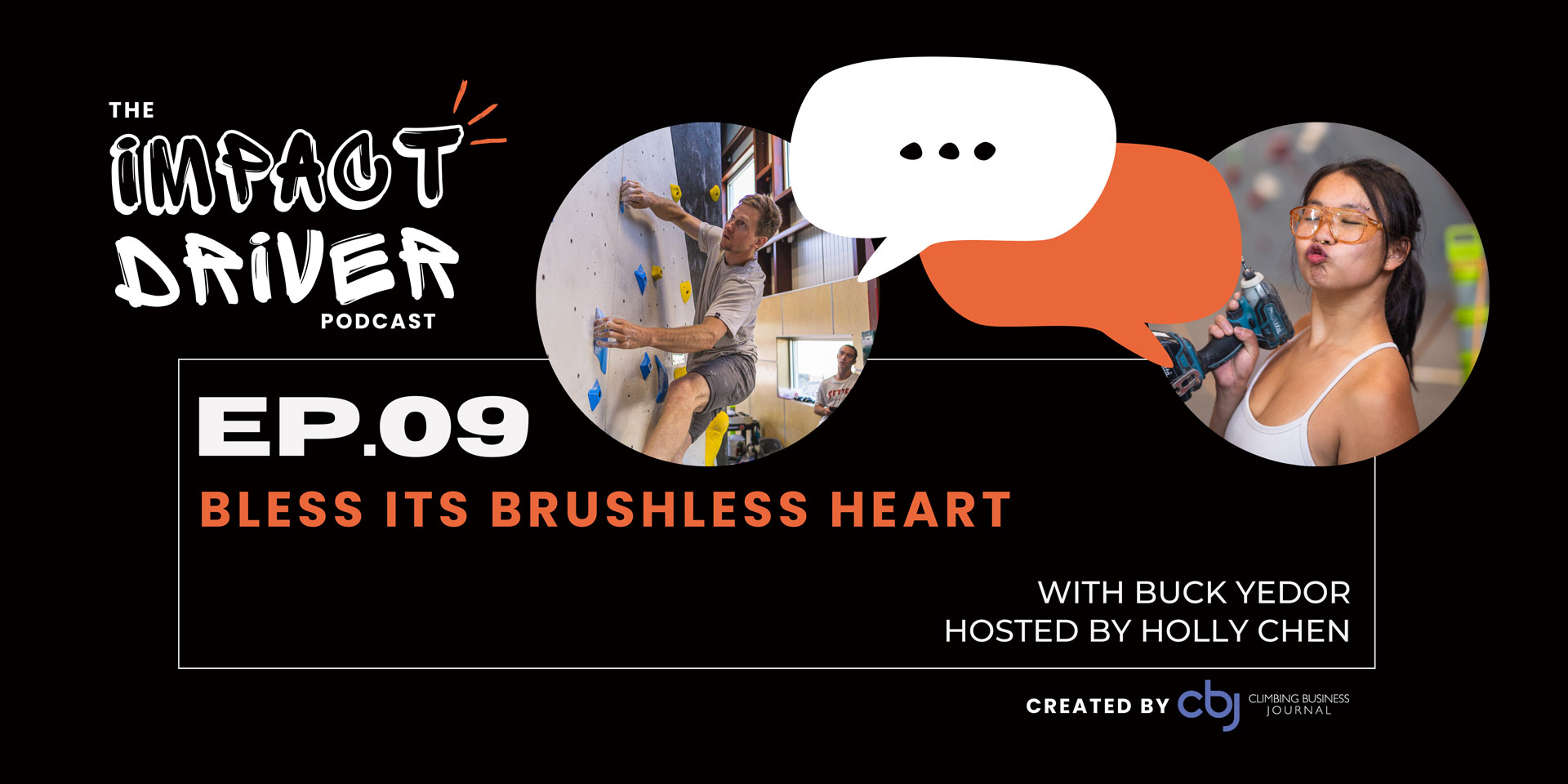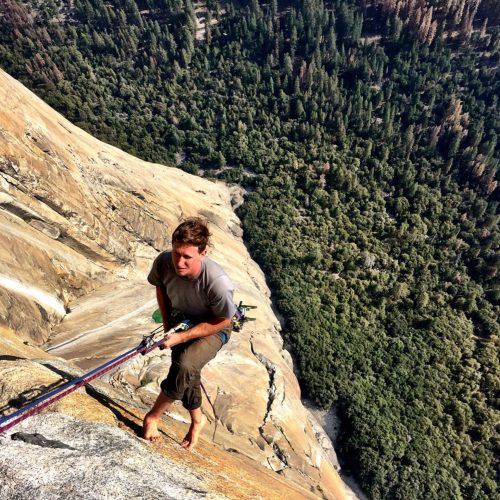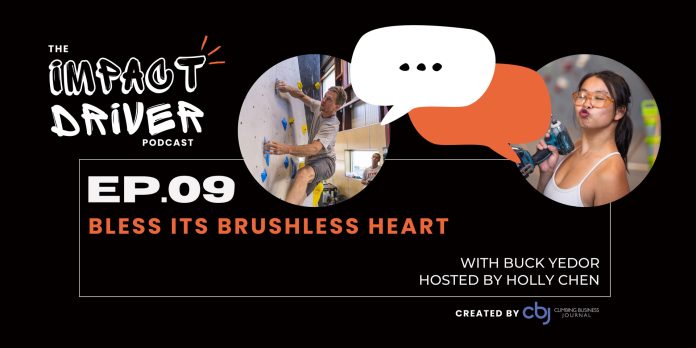
Today’s episode features Buck Yedor, also known as “Big Wall Buck” at The Spot Gyms in Colorado, where he oversees routesetting at The Spot’s five locations. True to his nickname in Colorado—and his Yosemite nickname “Bouldering Buck”—Yedor’s proudest climbing accomplishments include a ground-up free ascent of Freerider on El Capitan and double-digit boulders. Before The Spot, he worked on the Yosemite search and rescue team and was the Head Routesetter of Northern California gyms at Touchstone Climbing. Yedor has set for a couple of National Cups, chiefed the Battle of the Bay, and most recently set for both a sport and bouldering North American Cup. In this episode, Yedor covers the ins and outs of managing a multi-gym routesetting program and the importance of strong leadership starting from the top down. He also discusses the nuances of setting grade and quality consistency among multiple gyms under the same brand, building an environment of consistent learning, considerations for hiring novice setters, encouraging setters to explore different perspectives, and the ever-evolving trends of the routesetting industry versus the wants and needs of the community.
Thank you EP Climbing and Trango for your support!
And thank you Devin Dabney for your music!
Timestamps
00:00 – Intro
04:19 – Low-Density vs. High-Density Gyms
06:40 – Managing a Multi-Gym Setting Program
07:46 – Communication Among Facilities
09:58 – Yedor’s Vision for a Setting Program
11:21 – Maintaining Grade Consistency Among Facilities
13:45 – Developing Standardized Setting Protocols
15:57 – Giving Individual Setters Attention
18:26 – Monitoring Progress of Setters
19:53 – Hiring Setters Without Experience
22:09 – Chaos Mitigation
24:49 – A Continuous Learning Environment
28:14 – Yedor’s Drill of Choice
29:11 – Assessing the Community and Needs in Different Gyms
32:13 – Learning from Other Departments
34:05 – Catering to Different Climbers
36:48 – “Comp Kids” vs. “Broken Setters”
37:44 – Staying Up To Date on Trends
42:42 – Dangers of Consulting Only Social Media for Trends
44:46 – Challenges with Implementing New Safety Trends
49:40 – Yedor’s Final Message to Setters
50:08 – Closing
Abridged Transcript
…What is your most controversial setting opinion?
…I’ll start with just one. I think low-density gyms are super lame. I think they’re beautiful. I think as a concept they’re fun and I like visiting them. But I would never want my home gym to be the low-density kind of boutique-style gym. I think a lot of routesetters forget what it’s like to just be a member and be a rock climber and just go in and try to catch a sesh. And I think they look great, but I think in reality they’re just kind of lame…
[When managing a multi-gym setting program], how do you make sure that all of these gyms are talking to each other in an efficient and effective way? How do you make sure that all the head setters are on the same page, and all the setters under those head setters are on the same page?
Yeah, I think getting everyone in the same room—especially these days with Google Meet and stuff like that—it’s just really easy to be in constant communication. As far as getting my leads all aligned on the same page, we check-in. We have the four of us sit down for a meeting every other week, and sometimes it takes 15 minutes, sometimes it takes two hours. But we talk about how the crew is doing, what needs to happen, what they need. It’s where I can really kind of push my vision on what I want. Because whatever my vision is for a routesetting crew, it doesn’t matter unless my leads are fully on board with it, unless as a team we’re pushing the same agenda, the same styles, the same learning goals for our team. It’s awesome to have big dreams about what you want your program to look like, but unless you have really strong leadership a step beneath [you], it’s not going to happen…So for me, it’s really about having a really strong team of leads and having a strong shared vision…

Can you talk about your methods of how to maintain not just the quality of the routes and boulders, but the great consistency across multiple gyms?
…We share a lot of the same crew members across all of our gyms. So I think at a baseline, the same people are setting the boulders across all of our locations, which helps a lot. If you have two independent crews that never climb on each other’s stuff [and] don’t really know what’s going on at the other gym despite sharing a brand, [then] I think it’s really challenging to have any sort of real cohesive feeling between those facilities. But for us, everyone sets everywhere all the time, and I think that makes the grading consistency at least more consistent…
What about your methods for developing standardized setting protocols across multiple gyms? How do you make sure they’re consistent?
…That comes back to having all of the leads and myself really on the same page, and we meet about it and talk about it, and we talk about what’s important to us and what sort of standards we are going to push, and what’s happening at each gym. And if people are showing up and being like, “Hey, the lead over in Boulder says we don’t have to do this,” or “The lead in Louisville is letting us do this,” it’s stuff I like to hear about and we talk about, and we decide what we want as a program and to really make sure that the leads are pushing the same protocols. We also come together, sit down, write out what a day looks like: This is our start time, this is when we’re going to start stripping, and have the skeleton of a day lined out. So, [when] an employee goes from one gym to the next, I think it’s really helpful and important for employees to have consistency between facilities…
How can you, as kind of the director, step in and still give each individual setter the attention that they require to make the boulder—the vision—go, or work on something that we really care about developing, or finding the right professional development for each individual setter?
Yeah, I think that comes back to trying to be present as often as I can. I think there are a lot of days where I would probably be a lot more productive doing a lot of my administrative tasks if I was in an office or at home, just jamming away on my computer. But I think at the end of the day, being in the gyms, being accessible to the crew, is more important to the success of our department. And I’d be lying if I said I could, as the head of the program, be giving every individual the attention they need from me. I try to. I try. It’s really important to me to get to know everyone and what their aspirations are and what they’re working on…But I really have to give credit to the leads. Because I just can’t be that present. And I think when you get into even bigger programs—there aren’t a ton, but as we have more gyms, more setters, more people, the learning process for each individual setter has to be driven by [the] leads and the rest of the team even…
How do you go about assessing the community and what their needs are across each individual gym?
…It’s not crucial, but I think when I’m looking to hire people too, I think their knowledge and investment in the local communities is really helpful and something I see as a huge asset in hiring people—almost more than their climbing ability or to some extent, if all things equal, in their setting abilities. Are they coming from the local community? I love to hire people from the local community. And they generally have more of a sense maybe of what’s going on.
But sort of more important than the setting team’s knowledge of that—I think a lot of setters spend their time in the gym, [but] I’d be lying if I [said I] spent a lot of time in the evenings in the gym. So I rely on other departments in the company to really pass this on to me: the front desk, front desk supervisors, the coaching department, the adult program department…Everyone interfaces with the actual members a lot more than I do, for sure, so getting a sense of what people are asking for…

So if you’re talking to, let’s say, a desky who is there all the time—all day, every day—what are some questions that you can ask to help you gain a clearer picture of whether or not your approach to that gym is working?
Yeah, I think just checking in on the general vibe of the clientele. Are they happy with what is being put up? Are they generally hearing positive comments? I think getting into the weeds with comment boxes is maybe not always worth it…Oftentimes the squeaky wheel gets the attention, but the people who are really motivated to leave comments are often really polarized. And so just having a general sense from the guy or the woman who comes in every day, they chat with the desky, and they leave psyched. Or if they’re just like, “The routes lately haven’t been doing it for me. They’re boring,” or “The turnover’s not fast enough,” or “I wish there was those cool comp climbs you put up. I wish you’d do more of that.” Just getting a general sense of what the average customer’s day went like. Are people generally leaving happy? Are they coming in stoked when they see the new set? What are people saying?…
What do you think are some of the dangers of consulting only social media to keep in touch with trends?
I think it misrepresents what the average gym is doing. And even some of these really famous gyms that are putting out really cool content all the time, I think in the mind of the average setter who’s just consuming all this Instagram content, I think they are often kind of disgruntled about how lame their gym is. Like, “I wish I was just setting one boulder a day in these low-density, crazy, wild, dynamic coordination movements.” And I think from what I’ve heard, a lot of these gyms, or people, will film a boulder and forerun a boulder and then put that on Instagram without showing what the final gym product looks like. And it’s often much denser. They come in and do their filming and then go back and fill it in. And I think people just feel like they are getting the short end of the stick, having to set rock climbs…So I think people sometimes kind of lose the plot, if they spend too much time on Instagram, about what we’re really trying to accomplish…

Holly grew up in Taiwan and Hong Kong. Now she lives in Denver where she reports, writes and routesets. Beyond the Climbing Business Journal, her writing has been published by Alpinist Magazine, Climbing Magazine, Gym Climber and Sharp End Publishing. Holly’s motto has always been: “keep it interesting.”
Read our interview with Holly: Storytelling Through Movement










